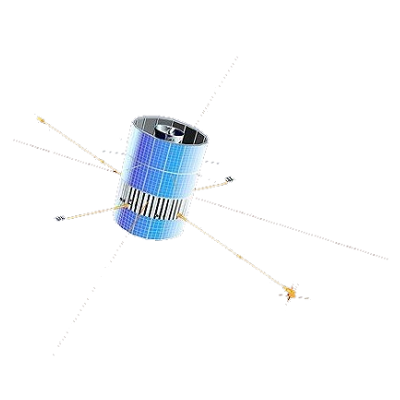IMP Charged Particle Measurement Experiment
at Fundamental Technologies
CPME Instrument Description
The CPME has two major components, the Proton-Electron Telescope (PET) and five thin-window Geiger-Mueller (GM) tubes. The PET measures and identifies electrons, protons, alpha particles, M-nuclei, and Fe-group nuclei. The GM array measures both solar X-rays and the more intense galactic X-ray sources.
PET Assembly
The PET can be best described by considering the unit as two subsystems: a) an array of three solid-state detectors, and b) supporting units that allow the solid-state detectors to operate to greatest advantage.
There are several supporting units in the PET telescope. These various components provide definition of look angle, anti-coincidence protection from backward and lateral penetrating particles, shielding from light, and mechanical support. They are the Plastic Scintillator Assembly which is used to form the anticoincidence shield from the solid-state detectors, the Optical Coupling Lens, the photo multiplier tube, the Tungsten Absorber, etc.
Solid-state Detectors
The three detectors are D1, D2, and D3. D1 and D2 are silicon surface barrier, totally depleted detectors placed close together near the front of the telescope. The geometrical factor for the D1D2 combination is 1.5 cm2-sr. D3 is a thick lithium-drifted detector placed farther back along the telescope axis. The geometrical factor of D2D3 coincidence is 0.32 cm2-sr. These three solid-state detectors, in an anticoincidence scintillator which will be discussed later, observed electrons between 0.2 and 2.5 MeV; protons between 0.3 and 500 MeV; alpha particles between 2.0 and 200 Mev; heavy particles with Z values ranging between 6 and 8 with energies greater than 32 MeV; and integral protons and alphas of energies greater than 50 MeV/nucleon, all with dynamic ranges of 1 to 1E+6 particles per (sq-cm-s-sr).
Return to IMP
Table of Contents Page.
Return to Fundamental
Technologies Home Page.
Updated 8/8/19, Cameron Crane
QUICK FACTS
Destination: The IMP-8 spacecraft spends roughly half of its 12-day orbit in solar winds, with the other half spent studying the magnetosphere and magnetosheath of Earth.
Orbit: The IMP-8 spacecraft orbits in a geocentric elliptical orbit with an inclination varying from 0 to 55 degrees.


